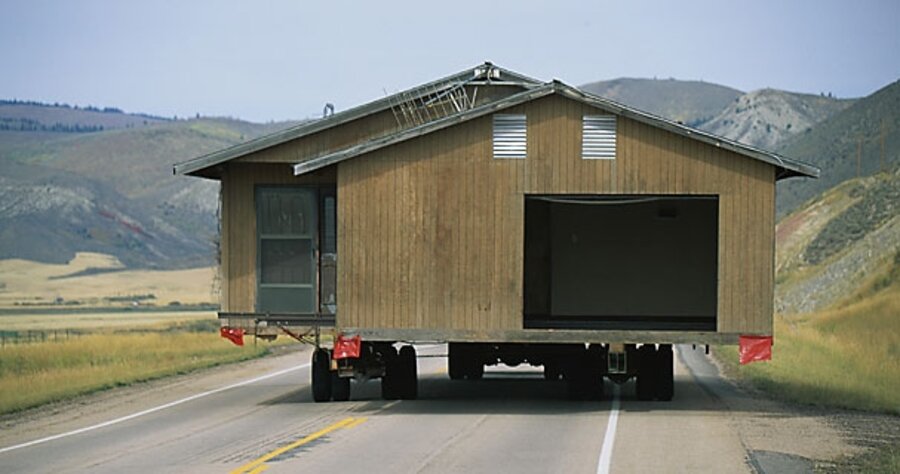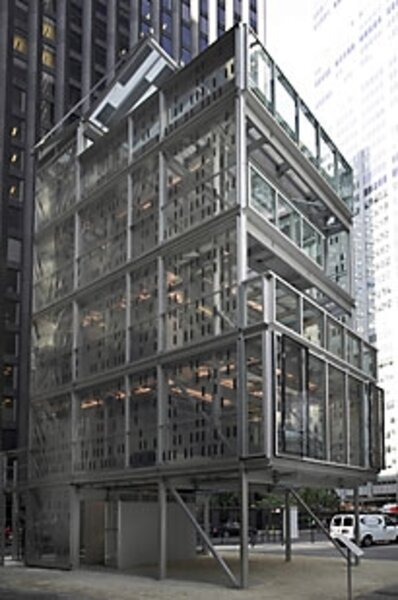Factory-built homes may be greener
Loading...
Factory-built homes have a PR problem: Too often they conjure up the image of tiny, temporary dwellings that are poorly constructed and potentially dangerous.
But that hasn’t stopped an intrepid group of architects and builders from pushing new ideas in what they call “modular” housing that they say are the way to a greener future for the building industry.
This summer, two exhibitions of modular houses – at Chicago’s Museum of Science and Industry (MSI) and New York’s Museum of Modern Art (MoMA) – are putting a spotlight on how off-site building techniques can shrink the carbon footprint of a new house.
Trailer parks have been associated with a low-cost way for the poor to put a roof over their heads. Last month the “FEMA trailers” distributed by the Federal Emergency Management Agency after Hurricane Katrina hit New Orleans three years ago came under fire when high levels of the toxic chemical compound formaldehyde were detected in some of them.
Prefabricated houses have had a “checkered” history over the last 150 years, acknowledges Stephen Kieran, a founding partner of KieranTimberlake Associates in Philadelphia. His architectural firm is displaying its Cellophane House modular home as part of the MoMA exhibition “Home Delivery: Fabricating the Modern Dwelling,” which runs through October.
The idea of housing arriving at the construction site at least partially prebuilt isn’t new. In the first half of the 20th century, Sears & Roebuck sold thousands of do-it-yourself home-building kits to Americans, with the lumber precut and nails included. Because standard components were mass-produced, costs were cut.
Today’s modular homes benefit even more from being built in a factory setting that includes computer-aided design and manufacturing techniques, proponents say. But many Americans still haven’t grasped how today’s product differs from the stereotypical mobile home, these designers say.
In the industry, trailers are referred to as “manufactured” housing. “Modular” homes are usually about 90 percent finished in the factory and shipped in discrete parts (usually limited in size to what can be transported on highways) that are then joined on the site. They can be of nearly any size or cost, from tiny cottages to mansions. They can look very similar to conventional site-built homes or have a distinctive appearance.
“People think that prefab is substandard because we have trailer homes,” says Michelle Kaufmann, founder and chairman of Michelle Kaufmann Designs in Oakland, Calif. Her firm is displaying an energy-efficient modular home as part of the MSI exhibition “Smart Homes” (on display through Jan. 4, 2009).
Factory-built homes make sense today as energy-saving and low environmental impact become more and more important features in a new home, designers say.
“We’re behind other countries that have really been embracing the benefits of off-site [building] technologies,” Ms. Kaufmann says. “The way that we’ve been building is so antiquated and so broken in many ways.” Building each home on site, she says, is “like asking for your car to be built in your driveway for you. It just doesn’t make any sense.... The technology is there, we just haven’t embraced it.”
Building a home module by module in a controlled factory environment results in 50 to 75 percent less waste of materials, Kaufmann estimates. Leftover materials aren’t exposed to the elements and damaged. Instead of being thrown in a dumpster, they are saved and used on the next home.
And because the home is largely complete when it arrives at the site, finish construction usually takes a few weeks, not months, saving energy by requiring fewer trips to the job site by construction workers.
By building indoors, workers can also more easily make sure that energy-saving features like insulation are carefully and properly installed for maximum effectiveness, Mr. Kieran says.
Individual home-building companies may not have the resources to keep current on the latest “high-performance building” techniques, he says. But modular homes can have state-of-the-art environmental design built into them at the factory.
KieranTimberlake’s modular Cellophane house at MoMA is a five-story dwelling with an aluminum frame that features translucent walls made from a plastic called PET, essentially the same material used in soda bottles. Because the frame is bolted together, not welded or glued, it can be disassembled and the materials reused when the house is no longer wanted. The plastic permits light, but not heat, to penetrate the interior. A passive ventilation system between inner and outer walls vents heat in summer and traps it as insulation in winter.
Photovoltaic cells embedded in the plastic generate electricity.
The house also contains an array of sensors that monitor how well its energy-saving systems are functioning.
“We think one of the frontiers of high-performance sustainable design is to have more information about performance, so that we can act on that information,” Kieran says. “As the cost of energy goes up and the cost of sensors goes down, you’re likely to see more of this in coming years.”
Other modular designers are building in additional sustainable features. HOM, a line of vacation homes designed by KAA Design Group in Los Angeles and launched in June, offers low-energy lighting and floors made from cork, a rapidly renewable natural wood. The HOMs range in size from 1,000 square feet to 3,600 square feet and are pulled on their own wheels to the home site in almost-finished condition.
Envision Prefab, another new startup based in Boca Raton, Fla., uses recycled 40-foot-long steel shipping containers as the building blocks for its modular homes. Smaller, simple versions can be used as temporary, low-cost, or worker housing. They feature waste composting, energy monitors for electrical systems, gray-water recycling, efficient LED lights, and flooring made from renewable bamboo. Insulation between the inner steel wall and a visually pleasing outer wall is made from recycled blue jeans.
Modular homes must undergo more stringent quality inspections than most site-built homes, says Bret Berneche, CEO of Cardinal Homes, a modular home company in Wylliesburg, Va. The National Association of Home Builders (NAHB) is in the process of completing a review of green building standards especially for modular homes, says Mr. Berneche, who also serves as president of the modular building systems council of the NAHB. Those standards will help buyers recognize when modular homes have met certain environmental criteria. His company already goes far beyond what local building codes call for by designing in many environmentally friendly features, he says.
Though the building industry is facing tough times right now, Kaufmann says her business is flourishing. In partnership with Urban Ventures LLC, Kaufmann is building 104 modular, eco-friendly townhouses, duplexes, and condominiums in the Denver area. “The housing market is not doing well, but our business is,” she says.
Adds Berneche: “I think [green building] is here to stay. It’s not a fad.”






